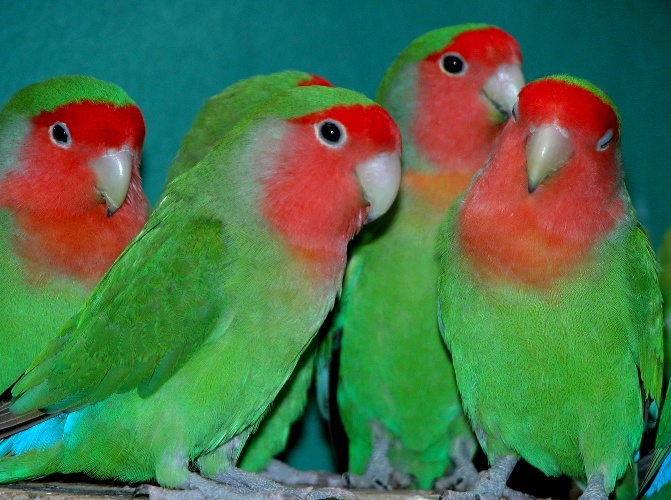
Rosy-faced lovebird, orRosy-collared lovebird, orPeach-faced lovebird(Agapornis roseicollis)
Phylum —chordata
Class — aves
Order — psittaciformes
Family — psittaculidae
Genus – agapornis
Appearance
The rosy-faced lovebird is a fairly small bird, 17–18 cm long with an average wing length of 106 mm and tail length of 44–52 mm. Wild birds are mostly green with a blue rump. The face and throat are pink, darkest on the forehead and above the eye. The bill is horn colored, the iris is brown and the legs and feet are grey.
Habitat
It inhabits dry, open country in southwest Africa. Its range extends from southwest Angola across most of Namibia to the lower Orange River valley in northwest South Africa.
Behavior
Rosy-faced lovebirdis a very social bird. It tends to move around in flocks of at least 5, with typical groups sizes ranging between 5 and 20 birds. At times, usually when grass seeds ripen in their natural environment, groups of about 100 are not uncommon.
Movement is primarily by flight, but over short distances these birds prefer to walk or sidle sideways. This species has been recorded flying at 58 km/hr. Long flights are regularly interrupted by periods of gliding. Gliding periods are most often accompanied by a characteristic squawking sound. These birds can climb up vertical walls using feet and beak, often beating their wings rapidly to facilitate movement.
Allopreening and bathing are behaviors observed in these birds, but water bathing in this species is far less common than in other Agapornis species.
When cold, the birds fluff their feathers out and even huddle together in pairs or in groups of 4 or 5 in order to conserve heat.
Rosy-collared lovebirdsleeps at night and is active in the day. At night these lovebirds roost in the nests of the white-browed sparrow-weavers or of sociable weavers.
Diet
The diet mainly consists of seeds and berries. It can sometimes be a pest in agricultural areas feeding on crops such as millet.
Reproduction
Lovebirds can start breeding when they are as young as ten months of age and may continue until they are five to six years. They are very prolific and may produce several egg clutches within a single year.
During breeding season, the behavior between partners will change: the male displays a more aggressive behavior, while the female begins preparing the nest. The nest is built in a rock crevice or within a compartment of the large communal nests built by sociable weavers. Man-made structures such as the roofs of houses may also be used. A total of 4-6 eggs are laid between February and April. They are dull white and measure 23.5 mm by 17.3 mm. They are incubated for about 23 days. The young birds fledge after 43 days.
In captivity
Peach-faced lovebirds live about 12 to 15 years or more if well cared for.
Don’t let the tiny size of the peach-faced lovebird fool you – they are small, but not fragile. Rosy-faced lovebirdsadapt easily, and are well known for being hardy and strong. To keep them healthy, pay attention to the conditions, avoiding the draft, damp and cold. Hygiene should be a priority, ensuring a clean environment for your pet to thrive.
As they are very social and function best in pairs, a solitary lovebird can become sick due to neglect and boredom – make sure you get at least a pair of them!
To achieve a balanced diet for your pet, besides the commercial seed mix, you’d want to add a healthy dose of fresh fruits and green vegetables.
Another thing to keep in mind is the hygiene, and the fact that peach-faced lovebirds absolutely love to bathe. Bathing dishes should be offered on a regular basis, to prevent feather related issues. Provide a roomy and large cage, as well as a lot of exercise time outside of it.
Peach-faced lovebirds are a pocket-sized bundle of fun. They are energetic and fun, but cuddly and affectionate as well. They will bond with their owner as time passes and trust is built. These birds are highly social, so consider keeping a pair for the happiest results. Sometimes they can be aggressive or territorial, biting strangers and other birds. A must-do for lovebird pets is toys. They love to play, goof around and climb about. To help them exercise and spend their energy, provide them with a lot of toys and perches. This good combination of desirable traits and healthy nature makes them a popular pet among avian beginners and experts alike.
 Russian
Russian
 English
English























